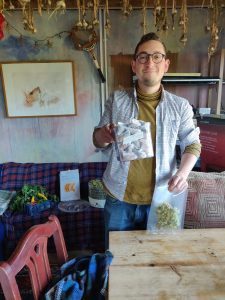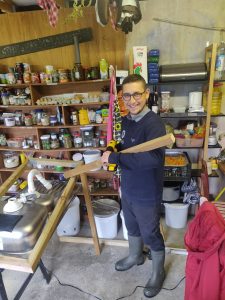Sometimes whilst wading through the pungent mud of a horse field or slumped on a haystack under the long line of conifer trees, I think back to my first impressions of Sadeh.
It was a Monday lunchtime, what feels like a long, long time ago. The sky was blue, the grass green and the hedges bursting with blackberries and damsons. Since that confusing day, approximately 5 months have gone by. Countless communal meals have been prepared and eaten, festivals celebrated and a volunteer experience like no other, intensified by pandemic regulations and the fun of socially distanced connection building.

From the perspective of a bird flying high over the field, I gaze at the seasons and how they have changed. At first, it was all about harvesting, gathering in the fruits (and the vegetables) of previous labour. A time of plenty – masses of leaves, blades of grass, vegetables and flowers all competing as to how fast they could leap out of the ground. Sunflowers straining languidly skywards, colourful petals dancing in the sunshine and herbs spreading the scent of summer. Food preparation was a matter of popping outside and simply plucking. Nature providing sustenance, seemingly without end, in a loving, kind and compassionate way.
As the stability of the sunshine started to wane and the waltz of the changing season came upon us, nature too started moving. Ripening hops begging to be popped off the vine and apples falling over themselves to be rescued from neighbouring fields, both headed into the fermenting room and a richly brewed future. Wheat from next door milled for winter flour and left behind peppers repurposed into hot sauce. The theme here seems obvious, an understanding of the bounty that nature gives us, but of its fleeting nature too.

All too soon the weather began to shake itself more and the ground, once so giving, lies there slumbering, activity moving inwards as we too make our way into a different mode of being, perhaps introspective, possibly more focused, definitely greyer. It becomes urgent to look after the surroundings, to mulch those baby trees, to weed the vegetable beds and dig the new formation before it gets too late. Digging up potatoes before they rot, brings with it a feeling of destruction, but wriggling worms surfacing in the autumnal twilight makes it special. DIY projects aplenty, transforming indoor areas into warm, welcoming, and ordered spaces for the long winter ahead. Minimal impact living comes into its own, with second, third, or fourth – hand furniture filling the void.
Accompanying us on this journey are the trees surrounding the farm. They give us some time to say farewell, with endless leaves now quietly decomposing down in a corner and sweet chestnuts aplenty. Roasted by the fire or turned into a deep, creamy jam, another reminder of what still lives out there, for us to touch, hold, cherish and use with utmost respect. As my Sadeh experience grew, my feet became more grounded in this green and pleasant corner of a land in turmoil. As my wellies got progressively more mud covered, so too did my confidence grow, at weaving dead hedges, at caring for wispy young trees, at looking after feathered friends and at planning for a permaculture future. A future for Sadeh that I may not be part of, but I know that the role I play today will ensure that what happens tomorrow, will happen right. Regeneration may sometimes sound like a theoretical idea, but on a day-to-day basis, it is what happens on every vascular level here.

Now in these dark January days, it is time to plant as many trees as we can find. When everything is at its grimmest, we plan for the sunshine. When the wind blows, gusting through the denuded branches of even the oldest oaks, we too are moved. Moved to change, moved to bend, moved to flow, moved to dance and moved to grow. Stagnation in this environment is nigh on impossible.
Winter peace and blessings to the fields and to all those who call them home.